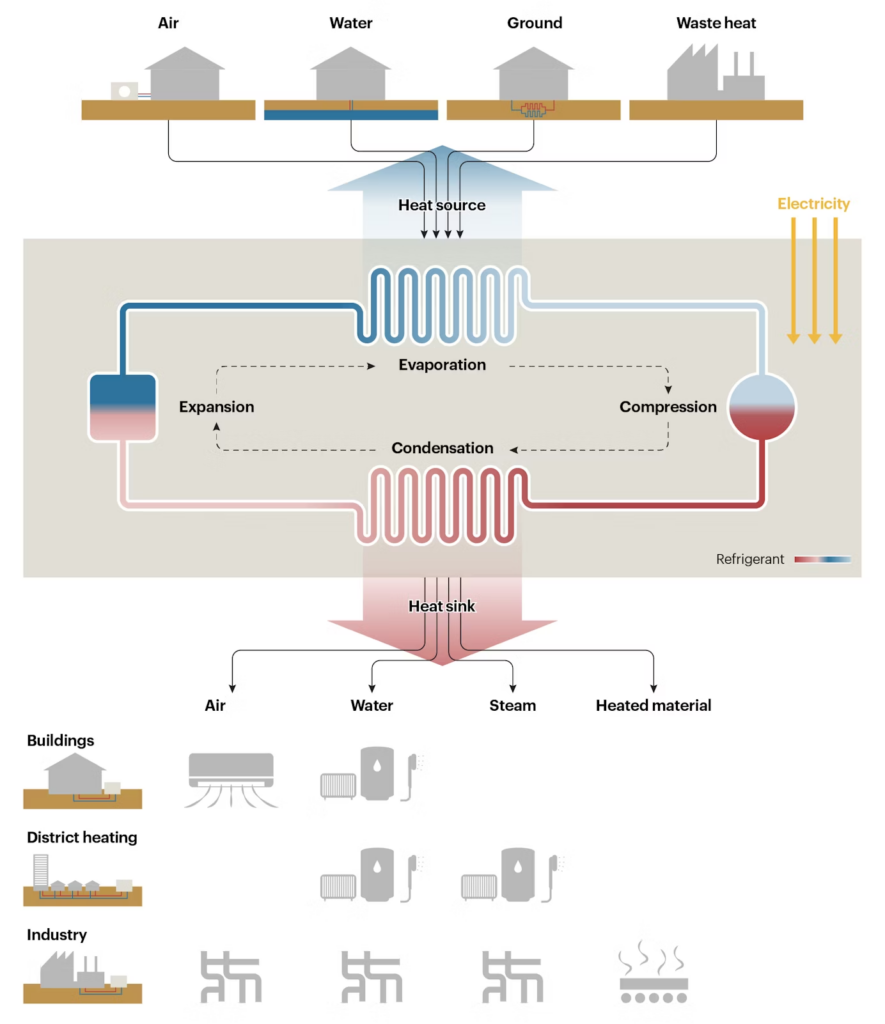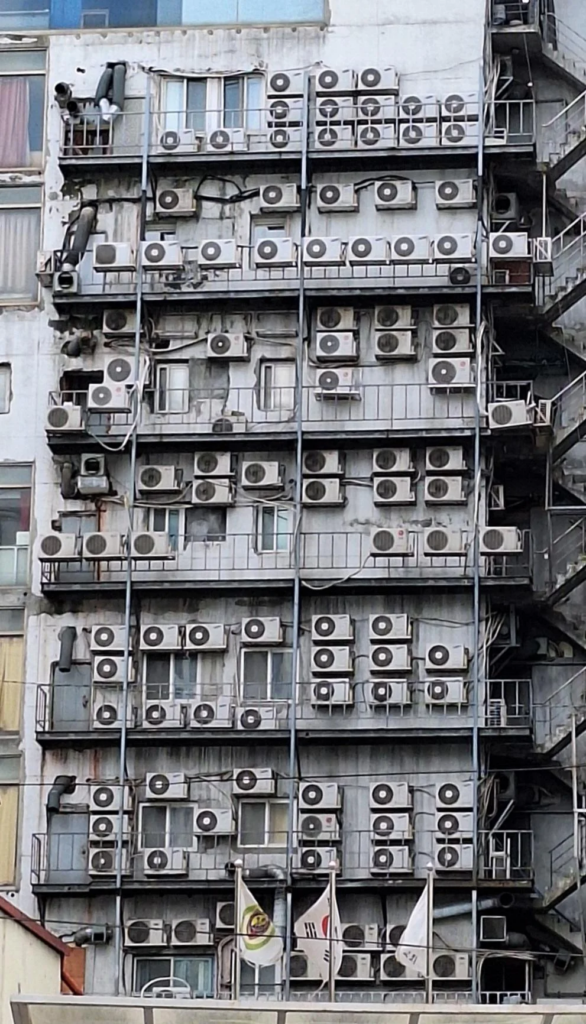Major part of our energy goes to heating and cooling. Heat is less useful and convenient than electricity, but by using, storing, moving, exchanging, condensing and sharing it we can use it more efficiently, reducing costs and peak energy use.
To do so you need a heat strategy for your activity and situation. This post doesn’t help you make one, but flickers through a few targets, techniques and tools that could come handy when you do.
Every company and every community or municipality should have a heating and cooling strategy for how they acquire, use and dispose of heat. Surprisingly many don’t.
A process uses energy to do work, e.g. to move something somewhere. That energy is never lost, it turns into some other form of energy, usually as wasted heat. However there should be no such thing as waste heat. Heat is a resource.
Using that resource cost-effectively requires planning. Enlightened self-interest can be enough to improve energy efficiency inside a building or factory (added costs upfront, but long-term savings), but handling heat as input and output also depends on coordination with others.
Heating and cooling is not just a side-effect of activity, but also a goal in itself. Half the energy used in Europe is on heating and cooling. More tropical continents might need more cooling than Europe does.
This can be divided into industrial use, such as heating for iron smelting and cooling for data centres, and to provide comfortable and optimal ambient temperatures no matter the outside temperatures.
| Activity | Normal clothing | Reinforced clothing | Thermal clothing |
| Sedentary work | 21-25 °C | 19-23 °C | 17-18 °C |
| Standing work | 13-19 °C | 10-18 °C | (8)-16 °C |
| Work in motion | 10-17 °C | (6)-14 °C | – |
Outside a fairly narrow range too high or low temperatures can be life-threating.
An energy primer: Electricity, fuel, and heat
Energy comes in many forms. Electricity is the most useable. It can efficiently be turned into any kind of work, as well as heating/cooling, and efficiently be transmitted over long distances.
Most energy today still comes in the form of fuels. Fuels, when burned, create heat. Heat can be used as is, or at a large efficiency loss turned into work or electricity by steam engines. The efficiency loss depends on several factors. The most important one is temperature difference. The greater the difference between the hot and the cold part, the more efficient this process can be. Furthermore the lost energy will be in the form of waste heat, which can be used for other purposes.
Fuels is not the only source of energy. Every activity produces heat as a side-effect. The sun is our primary energy source, but the Earth itself is also a huge reservoir of useable energy (geothermal energy).
Renewable energy uses the energy from the sun directly (solar power) or indirectly (wind, wave and hydroelectric power). Geothermal power can also be used. Nuclear power uses the heat from nuclear fission to run a steam engine.
Heat storage, transfer and reuse
Like electricity, heat can be stored, just not as well. It can be moved, just not as easily. It can be reused, but not indefinitely. Heat management will be local and short-term, and the business cases will be more complicated.
Staying hot
First step in remaining hot is good insulation. That slows the process of heat leaking from where it is to where you don’t want it to be. It can sometimes be hard to predict where it leaks, a heat camera (thermal imaging camera) is useful here. When well-insulated a heat store shouldn’t stick out too much from the background.
As power consumption has its rush or peak hours, generating heat ahead of time may be a good strategy, as with this case of electric storage water heaters.

The business case here is that these water heaters are already installed to offer hot water for domestic purposes. Adding price or time sensitive electronics is a small extra cost, which will get smaller as more are produced (learning curve). Any heat loss will increase temperature in the room they are located.
Heat batteries, or thermal energy storage (TES), will be significantly larger as there is a benefit of scale. The storage capacity of a TES will depend on volume, material, and temperature
While a small storage like a water heater can store heat for a few hours, large enough storages can last over a full year.
More is under construction:


Carrying heat
But for heat to be useful, it must be moved to where it is needed. The above thermal storages use district heating, which works well in an urban or dense suburban setting.
Without it, even with it, moving heat any distance is a challenge and a cost, which puts an upper limit on how large heat stores are likely to be.
Heat could also be stored and moved in mobile units like storage containers, but this strategy will have a hard time competing with comparable batteries.
Condense the heat
Heat normally flows from hot bodies to cool bodies (the second law of thermodynamics), but by expending energy it is possible to move heat in the opposite direction. That is the principle of heat pumps.

Heat pumps can be pretty beneficial in themselves (calculated in energy, space, time and money), but can also affect cost/benefit calculation for the system as a whole.
Share the heat
Given a community, residential or industrial, some will produce heat while others will need it. The profiles will vary. A data centre consumes energy, and produces low-temperature heat, on instant demand. A blast furnace has some more leeway for when the high-temperature heat is acquired, measured in hours, not days. A greenhouse must have the correct ambient temperature, no matter the weather outside. Colocation is a useful strategy.
Case: Hammarby sjöstad
Case: combine Edge data centers with greenhouses

Heat is usually released either into water or into air. Heat exchangers is one way to use waste heat leaving a building to warm up water or air entering it.

Heat can sometimes be turned back into electricity, but see the section above on heat engines for efficiency cost.
The cool alternative
Cold in many aspects is just heat in reverse. Thus we got cold storage, district cooling, and refrigerators and air condition (A/C) units are just heat pumps keeping a place cool instead of warm.
A century ago most of the technology and wealth remained in relatively cool climates where heating was the main issue. This century warmer regions of the world are catching up, and more energy will be spent on keeping people cool than on staying warm.
However, there are some extra complications. Inefficiencies are less of a problem in heating, any energy loss turns into heat, which is what we want. Heat loss from district heating warm up pavements, which is not necessary, but still nice.
Cooling is not that easy. While there are plenty of heat sources, and fuel can be burned where there isn’t, there are not that many sources of cold. To cool down somewhere, somewhere else will have to be heated up. And waste heat is no longer an opportunity. It is a rapidly accelerating problem, turning heat islands hotter.
Pumping heat and moisture out of your apartment heats up the outside, turning it and the energy wasted from the A/C into your neighbours’ problem, so that they have to crank up their A/C units exacerbating the problem. The outside may turn from marginal to practically unliveable, while the power use spikes at the hottest hours, forcing power companies to burn more expensive, usually fossil, fuels to meet demand, heating up their environment and contributing to global warming.

The best technique is to avoid buildings being heated up in the first place, by shielding building walls and particularly windows from the sun’s heat. That can be done by an external wall (a variant can be used to distribute heat in colder environments), painting exposed walls and roofs white.
Passive cooling does the work of A/C without the waste heat. Evaporation cools down the area in question (input water, output steam), by vegetation or other process. District cooling most commonly uses a lake or similar as a cold reservoir (heating it up in the process). Heat radiated into the night, and potentially into space, will also cool down an area.
Most people live in temperate areas, with cold winters and hot summers. Heat storage can also work as cold storage. Ice houses is one of the oldest techniques to keep cool. There have been attempts to do modern versions, but for practical reasons they have not been cost-effective. Borehole heat exchangers or other forms of geothermal heating/cooling have proven less troublesome.
Globally, of course, we would be better served by mitigating climate change. We have a fairly short interval to produce techniques to cool down ourselves without heating up everyone and everything else.